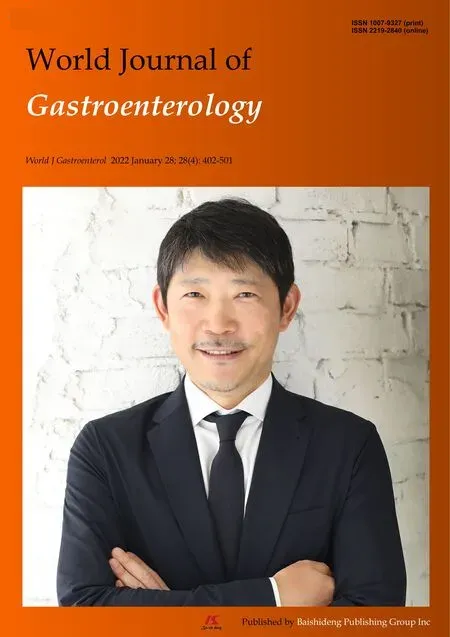lnterplay between chronic hepatitis B and atherosclerosis:lnnovative perspectives and theories
Ivan Rankovi?,Vladimir Milivojevi?,Aleksandra Pavlovi? Markovi?,Mihailo Bezmarevi?
Abstract Elaboration of carotid atherosclerosis in the setting of hepatitis B virus (HBV) infection should emphasize the significance of extrahepatic manifestations of the infection pathogenesis.Diverse processes comprise the pathoevolution of HBV infection,rendering it a multi-systemic disease in its essence.Our work not only exemplified atherosclerosis as an often-underestimated contributor to the severity of HBV infection but has also highlighted the bidirectional relationship between the two.Therefore,it is suggested that HBV-induced inflammation is one of the root causes of atherosclerosis,which in turn has a consequent effect on the severity of the chronic infection disease state,creating a vicious cycle.Additionally,we coupled prior data with the current concepts of HBV infection to postulate intriguing perspectives and theories.
Key Words:Hepatitis B virus infection;Carotid atherosclerosis;Hepatitis B e antigen;Arterial inflammation;Perspectives and trends
TO THE EDlTOR
We read with interest the study of Riveiro-Barcielaet al[1] which elucidates the possible interplay between hepatitis B virus (HBV) infection and carotid atherosclerosis.It has high-yield trial properties due to its large sample size and prospective method.Although its inclusion and exclusion criteria were precise and broad,as with any case-control study,there remains the possibility of bias as a consequence of inferring causation from statistically significant co-relations which can be complicated by difficulty in determining the chronological order of exposure to HBV (i.e.the starting time of infection and latency).
The authors concluded that the presence of subclinical atherosclerosis and carotid plaques were more frequent in patients with HBV infection than in controls and that liver damage was an independent factor associated with subclinical atherosclerosis and carotid plaques,regardless of the presence of classical cardiovascular factors.
In general,we agree with the authors,since many of our patients render a similar atherosclerotic disease profile which cannot be attributed solely,sui generis,to the cardiovascular substrate.Therefore,their study’s findings have the capacity not only to raise the index of suspicion of a practicing clinician but to optimize the established diagnostic framework of HBV patients in order to prevent atherosclerosis occurrence and complications.
Furthermore,the study implicates chronic HBV infection ?i.e.the specific point of the na?ve hepatitis B e antigen (HBeAg)-negative phase ? as being an important atherosclerotic contributor.Conversely,a prior study by Tonget al[2] has concluded that HBV infection not only negatively correlates with C-reactive protein (CRP) levels but seems to not be associated with coronary atherosclerosis.Additionally,Kiechlet al[3] found no significant association between chronic hepatitis and the development of new carotid atherosclerotic plaques;although,they did not specify the type of hepatitis virus.Of course,these conflicting results have to be considered cautiously,as they originate from patients in different phases of the HBV infection and divergent research materials and methods.With all this said,it may be that the window of opportunity for early atherosclerosis detection and preemptive therapeutic intervention in HBV could represent the subpopulation of na?ve and HBeAg-negative patients.
However,the general discrepancies in the conclusions of the aforementioned trials made us postulate some intriguing perspective theories.First,it may be that HBV infection harbors specific propensity towards anatomically different vascular structures,thereby affecting carotid arteries more often than coronary arteries.This notion is in concordance with the previously published data inferring that viruses have different sites of endothelial predilection[4].Second,we may utilize other,more sophisticated inflammatory markers,namely high-sensitivity (hs-)CRP with or without homocysteine for optimal HBV patient stratification regarding atherosclerosis risk[5].Third,the potential role of macrophage phenotype variation during HBV infection may be one of the crossroads between the processes of atherosclerosis and HBV infection[6].Current cardiology investigations have revealed the significant role of macrophages,encompassing their local,endothelial,as well as systemic effectsviaThelper lymphocytes and cytokine release modulation[7].Having stated that,we postulate that HBV infection may trigger macrophage phenotype alteration,rendering it to be a contributive precipitant of atherosclerotic disease as well as the crosslink point between the two diseases.Last but not least,the study of Riveiro-Barcielaet al[1] may open the door for broader statin use,addressing two end goals concomitantly:Lowering the risk of cirrhosis and hepatocellular carcinoma in viral hepatitis patients[8],and engaging in the prevention and treatment of atherosclerosis and its complications.
We believe that prospects in this field should be diversified in the manner that onesize does not fit all.Upcoming trials and future viewpoints should render better comprehension of the delicate HBV pathodynamics from which implementation of optimized and specific therapy would be more feasible.
Our group envisions many possible pathways between HBV infection and atherosclerosis,i.e.cardiovascular diseases which may be potential targets for clinical management,and thus encourages future research work in this field.
 World Journal of Gastroenterology2022年4期
World Journal of Gastroenterology2022年4期
- World Journal of Gastroenterology的其它文章
- ls CA19-9 effective in predicting chemotherapeutic response in patients with synchronous liver metastases with colorectal cancer?
- Fibrinogen-like protein 2 deficiency inhibits virus-induced fulminant hepatitis through abrogating inflammatory macrophage activation
- Knockdown of DEAD-box 51 inhibits tumor growth of esophageal squamous cell carcinoma via the Pl3K/AKT pathway
- Celiac disease:From genetics to epigenetics
- Sarcopenia in hepatocellular carcinoma:Current knowledge and future directions
- Gut bless you:The microbiota-gut-brain axis in irritable bowel syndrome
